It’s Puthari once again, and this year I’m hearing how the standing rice crops have been badly affected by unseasonal rains in some parts of Coorg. In other places, large areas have been destroyed by elephants, wandering further in search of food, after the mass flowering and subsequent withering of large tracts of the bamboo forests not long ago.
As every farmer knows too well, all the year’s work can come to nothing in the blink of an eye, and losing that precious rice crop means hard times for the family and community. Rice is the staple of millions of people around the world, and of course it really is the heart of Kodava cuisine. Where would we be without akki ottis and all the many kinds of puttus?! When those new grains of paddy are sprinkled on the Puthari payasa, it’s a moment of thanksgiving and hope for the year ahead.
With the easy access most of us have to foods grown far from the place we call home, Puthari is a good time to pause and give thanks to those anonymous farmers whose hard work puts the food we eat on our plates.
One food that is closely associated with Puthari celebrations, is the Puthari kalanji – a variety of yam that is harvested at this time of year.
The yams you see in the picture at the bottom of the post were very large, weighing 3 or 4 kilos each. If carefully stored, this yam can last for months, providing a valuable addition to the kitchen stores when supplies are low. By some accounts, eating kalanji before going to cut the kad can be seen as being symbolic of lean times, before the arrival of a new crop.
Puthari kalanji is peeled, boiled in salted water, and then served topped with grated coconut, roasted sesame, ghee, and some jaggery syrup or honey. It has a firm, smooth, texture, and a mild earthiness, far less than its rugged exterior would suggest!
In Vancouver’s diverse markets, I can find yams, fresh, frozen, and dried, that have travelled a long way from their native soils. But no Puthari kalanji. What is also available in abundance, is an assortment of sweet potatoes*. My grandmother often served sweet potato up at tea time, with grated coconut, ghee and sugar.
Thanksgiving meals in Canada and the US often feature the orange fleshed sweet potato on the menu. So this year, instead of thambuttu, my Puthari Thanksgiving across continents was a breakfast of assorted varieties of sweet potatoes, steamed, then given the Puthari kalanji toppings (see above). Colourful, delicious, and the happiest surprise came in the form of the purple Japanese variety, which when cooked, had the sweetness and fragrance of…honey!
Happy Puthari!
*Sweet potatoes are also known as kalanji, or bella (jaggery) kalanji.

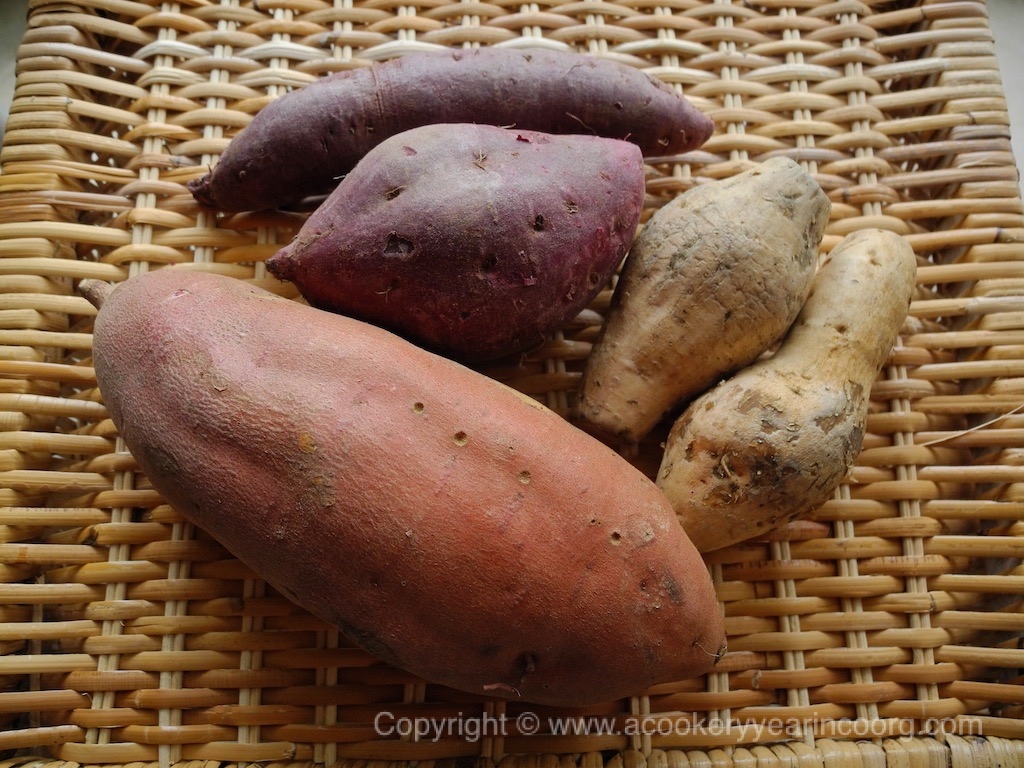
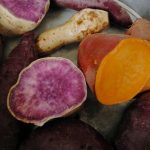
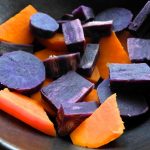
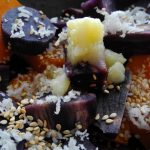
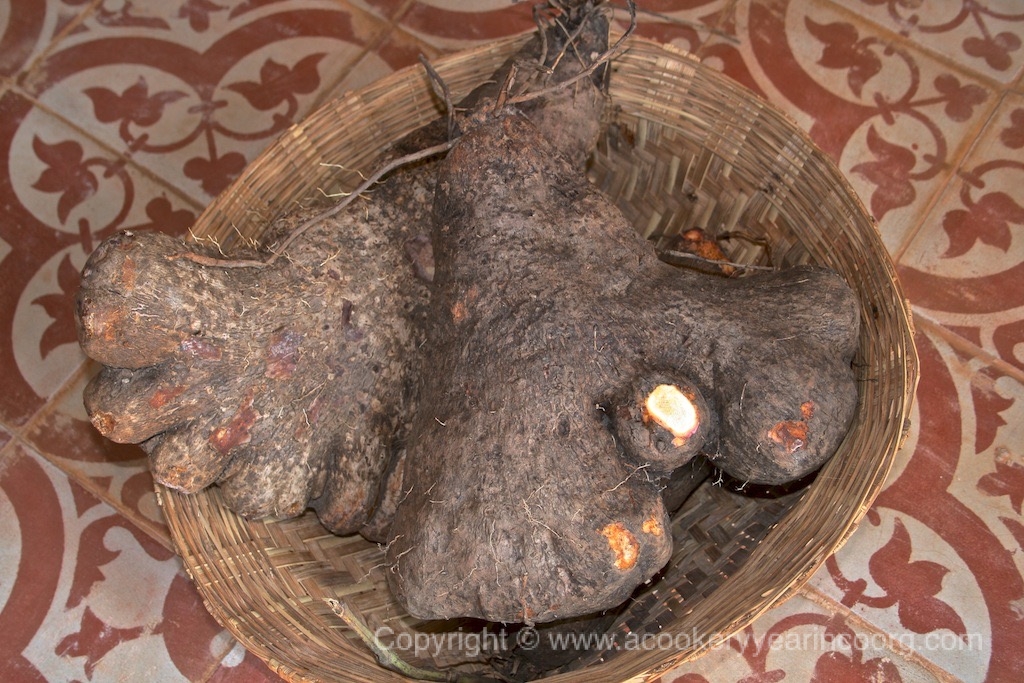
A blessed Puthari to all. A beautiful post and the pictures are a delight. Sweet potatoes somehow herald winter . I have memories of these goodies being baked on coal fires on hand carts on market streets. Such an awesome treat , with the smokey flavour form the coal. I believe they are packed with Vit A . For the poor labourer who would invariably buy some what a lovely and most inexpensive meal this must be . To be honest I never liked them preferring any day a plate of french fries which I would slather with tomato ketchup and could never understand what the big deal was about a Sweet Potato, my mother steaming a small batch everyday , and would turn my nose up at them / This year’s Puthari and your post has finally made me understand the beauty and wholesome goodness of seasonal produce . To appreciate these and partake of it. I must keep an eye out for them this winter and have some . The food that we eat…….! No wonder we were made to say grace before lunch in school ( which we said with ill grace I must confess racing through the words of gratitude , eating them up mostly in a hurry to get out of the class room. My biggest fear is that people will stop farming and one day we will have nothing to eat . Even in a good year for the farmer with a small land holding the returns are modest at the most and all over the world they are completely at the mercy of nature , as you have mentioned . We hardly give them a thought , here in India the situation is precarious and frightening . It took me some years of growing up to realise that I should be very grateful for the food in my plate . So much of our life revolves around food , the cultivation marketing , buying groceries , thinking up and planning menus putting together all kinds of meals ranging form the simple to the hearty and sumptuous , the rustic or elegant repasts . Yet in the midst of all this the toils of the farmer are all but forgotten. Unlike wheat no aspect of rice cultivation can be mechanised and it is such a labour intensive process. So let us say thanks and let us enjoy. Loved the post Shalini, the beautiful pictures and a thought for those who give us our daily bread. PS is the Puthari Kalanji a yam or sweet potato.
Thank you, Jyoti, and the same to you!
Funny thing is, I didn’t much care for sweet potato as a child either. I disliked the dry, crumbly stuff we were served up in school ( after we had dutifully said grace) and rarely ate it if my mother served it at home. In Coorg, it was a different story 🙂 Of course I loved those potato “finger chips and sauce” a whole lot more!
It’s so important to have a connection to the local farming community in some way, though living here, I would be a non-starter in the 100 Mile Diet challenge
http://en.wikipedia.org/wiki/The_100-Mile_Diet I love my rice too much! I haven’t met a variety of rice I didn’t like, but my first loves are still basmati and the lovely, small grained “sanakki”, which is grown less in Coorg now. The sight of ginger being cultivated in paddy fields is disturbing enough, but my heart really sinks when I see buildings being constructed on paddy fields. There’s such an ominous finality to that. 🙁
Puthari kalanji is a yam (Dioscoreaceae) It’s a variety that is fairly easily cultivated, and you’ll probably see the vines wrapped around trees in some estate kitchen gardens. The yam or sweet potato debate comes up here every year around Thanksgiving, because of the USDA’s labelling of the orange fleshed sweet potato as a yam, to distinguish it from the paler variety. So those “candied yam” dishes are really candied sweet potatoes!
Thanks for reading 🙂
Ok and yes you have stated that in the picture as well. Buildings where there were lush emerald green paddy fields is the horrid point of no return . So much of the world population lives on rice . I sent you a recipe of a sweet potato cupcake 🙂 . This winter am keeping an eye out for the sweet potatoes. MIL always says potatoes . very very bad , but sweet potatoes are very good . I feel guilty whenever she says this as my mind is always conjuring up visions of Aloo Tikki, French Fries or a hearty potato salad . But age makes on wiser and this winter I will give them a go .
🙂 Sounds like your MIL doesn’t trust those foreign tubers at all!
Thanks for the cupcake recipe. I like the sound of the marshmallow topping much better on a cupcake than on candied yams.
My grandmother made a kind of fritter with sweet potato- let me see if I can rustle some up this winter!